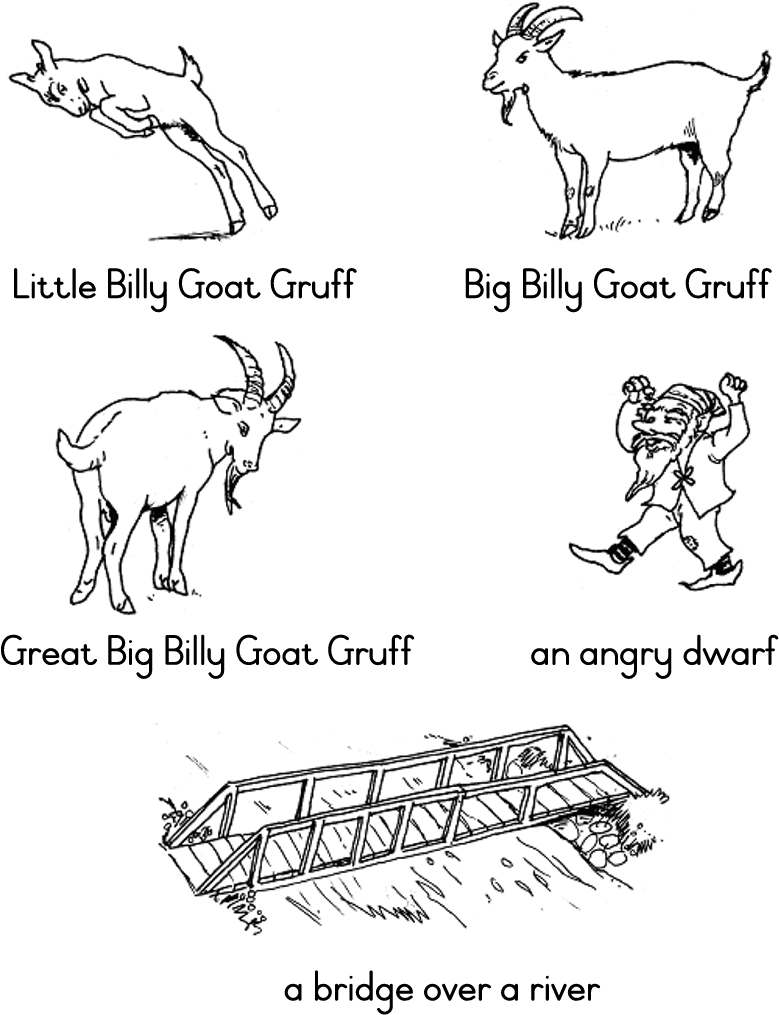| << Chapter < Page | Chapter >> Page > |
In Grade 3 learners continue to expand their vocabulary by listening and reading a variety of texts such as poem, stories, riddles and doing word puzzles.
These modules consolidate and revise the vocabulary and phonics introduced in Grade 2. More opportunities are given for written work producing longer texts of more varied kinds. Learners should not be afraid to make mistakes as the building of confidence and fluency should take priority above perfect written work.
Time scheduled for the modules
All learners should work through all eight modules as the phonics and spelling requirements are spread over these modules. The educator should however allow learners to complete them at their own pace namely ± two modules per term.
The story of “The three Billy Goats Gruff” allows for questions to the answered, missing words to be filled into sentences and illustrations to be made.
Many new concepts and ideas are introduced in the poem “Story time” and educators can use these to initiate interesting discussions.
The dangers which the three Billy Goats had to overcome can lead to dangers in the learners’ environment and means by which to overcome or avoid these.
The goats were in search of good food. Children should be cared for and food should be available for everyone.
Privileges should not only be for a few but should be for everyone.
I love to hear the stories
of long, long ago,
how places were discovered
and where the wind will go.
Of giants up on the hilltops
and monsters in the sea,
of spaceships in outer space
and where the Queen drinks tea.
There are many lands to visit
in my bed at night.
The stories take me far away
as I watch the stars so bright.
But – now it’s time for bed I see
and mother calls, “Put off the light!”
For Mr Sandman, he’s been here
and I’m oh so sleepy – good night!
G.J.M.
| LO 1.1 | LO 2.2 | LO 3.2.1 | LO 3.8.1 |
…………………………………………………………………………………………..
…………………………………………………………………………………………..
…………………………………………………………………………………………..
…………………………………………………………………………………………..
…………………………………………………………………………………………..
…………………………………………………………………………………………..
…………………………………………………………………………………………..
…………………………………………………………………………………………..
| LO 2.1 | LO 3.2.3 | LO 4.6 |
| m as in man | s as in sun | b as in ball |
| d as in dad | f as in fox | h as in house |

man

moon

dad

donkey

sun

sand

fox



ball

bus

house

hand
| LO 3.7.1 |

| LO 1.1.2 |
Learning Outcome 1: LISTENING : The learner will be able to listen for information and enjoyment, and respond appropriately and critically in a wide range of situations.
Assessment Standard 1.1: We know this when the learner shows understanding of stories:
1.1.2 predicts what the story will be about from the title;
Learning Outcome 2: SPEAKING : The learner is able to communicate confidently and effectively in spoken language in a wide range of situations.
Assessment Standard 2.1: We know this when the learner answers questions using words and phrases;
Assessment Standard 2.2: We know this when the learner performs a rhyme, poem or song;
Learning Outcome 3: READING AND VIEWING : The learner is able to read and view for information and enjoyment, and respond critically to the aesthetic, cultural and emotional values in texts;
Assessment Standard 3.2: We know this when the learner begins to make meaning of written text by reading with the teacher:
3.2.1 reads the title;
3.2.3 answers literal questions about the story;
Assessment Standard 3.7: We know this when the learner develops phonic awareness:
3.7.1 recognises differences in pronunciation between home and additional language;
Assessment Standard 3.8: We know this when the learner develops phonic awareness:
3.8.1 reads and follows instructions (e.g. how to play a game).
Learning Outcome 4: WRITING : The learner will be able to write different kinds of factual and imaginative texts for a wide range of purposes.
Assessment Standard 4.6: We know this when the learner writes own sentences without a ‘frame’ (e.g. expressing feelings and personal opinions).

Notification Switch
Would you like to follow the 'English first additional language grade 3' conversation and receive update notifications?